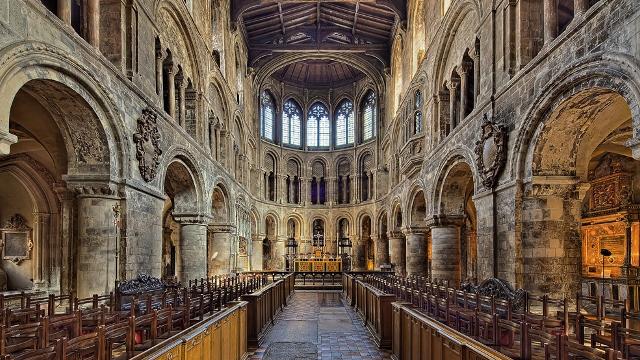Today I went on a visit to London organised by the Oxford University Heraldry Society. As always on their excursions one was taken to places of great historic as well as heraldic interest, and on this occasion all of the places I visited were for the first time.
Our first visit was to the headquarters in Clerkenwell of The Most Venerable Priory of the Order of St John of Jerusalem in the British Realm - the Anglican version of the Order of Malta, which was re-established in the nineteenth century under the patronage of Queen Victoria and her successors. There is an online history and introduction to the Order at Order of Saint John.
The site in Clerkenwell is that of the medieval Preceptory, and although only the gatehouse and part of the church survives, and now separated from each other by a road and other buildings they are still a remarkable survival.
The Church originally had a circular nave modelled on the Holy Sepulchre and similar to that of the Temple Church. That was replaced in the middle ages by a rectangular nave, but a curving foundation wall has been exposed. The chancel survived the dissolution and evolved into a fairly typical London eighteenth century church, which was a casualty of the Blitz. The post-war rebuilding emphasised the
medieval remains in a light and airy church, which displays the banners of the knights and of the modern Commonwealth preceptories.
The restored Priory Church
Image: museumstjohn.org.uk
The Crypt
Image: museumstjohn.org.uk
The Museum and headquarters of the Order are housed in the much better known early sixteenth century gatehouse to the original complex.

The Gatehouse
Image: Wikipedia
Here were displays and material including portraits and pictures of Malta illustrating the history of the original unified Order, and the attempt by Tsar Paul I to take it over at the very end of the eighteenth century. The Chapter Hall and Council Chamber were richly decorated with the arms of Royal and aristocratic members of the Order.
The Chapter Hall
Image: museumstjohn.org.uk
There are pictures of the interiors and more information on the Museum's website at The Church - Museum of the Order of St John.
There is more about the history of the site at Clerkenwell Priory and about the church at St John Clerkenwell. There are more detailed accounts at St John's Church and St John's Square | British History Online from the Survey of London and at Clerkenwell Priory · Medieval London
When we came outside I was struck by the warmth of the air - the first real indicator that spring is here.
After walking through Smithfield market - the same place I remember as a child seeing burning down on television in the late 1950s and now handsomely restored - we had lunch in Smithfield and walked round the open space, noting the plaque commemorating William Wallace's execution there in 1305 and thinking of King Richard II's meeting with the Kentish peasants there in 1381 and the death of Wat Tyler. We also noted the gate to St Bart's Hospital and its statue of King Henry VIII and the tower of St Bartholomew the Less within the hospital.
We met up again as a group at St Bartholomew the Great on the eastern side of Smithfield. The remains of the priory church are hidden away through a timber gatehouse that leads to a oath on the site of the nave. At first the church with its relatively modern tower in the Tudor style is a little confusing, but what survives are parts of the transepts, the twelfth century choir and chapels of the ambulatory and a thirteenth century Lady Chapel.

The choir of St Batholomew the Great
The apse is a skillful nineteenth century restoration
Image: Visit London
The oriel window in the triforium for Prior William Bolton (1505-32) to observe the church and canons
Image:Britain Express
What remains is very impressive and it must have been a very fine building indeed before the sixteenth century depredations. It was really quite amazing to be standing in part of medieval London, a building which had survived so substantially intact the ravages and rebuildings of the last five centuries. Our visit was enhanced by the fact that we had an excellent guide from the church.
The choir elevation and the tomb of the founder Rahere
Image: Britain Express
There is more about the history of the Priory and church at The History of St Bartholomew the Great
and at St Bartholomew-the-Great
After that the formal tour was over but together with a friend I explored the area round about and walked up to look at the exterior of Charterhouse. Not only is this the site of the medieval London Carthusian house founded in 1371 with its great spiritual reputation and martyrs of the 1530s but it has a connection with Bishop Fleming - he blessed a bell for the community in the late 1420s when he had the semi-official role of patron of the English Carthusians. Having served as the home of the unfortunate fourth Duke of Norfolk, the present charitable foundation of Charterhouse owes its establishment in 1611 to Thomas Sutton ( 1532-1611). The Oxford DNB life of him can be viewed at here . There is more about it at the homepage The Charterhouse

The front of Charterhouse
Image: Diverting Journeys: WordPress.com
This was a most enjoyable and informative day out and one on which one learned a lot.

No comments:
Post a Comment